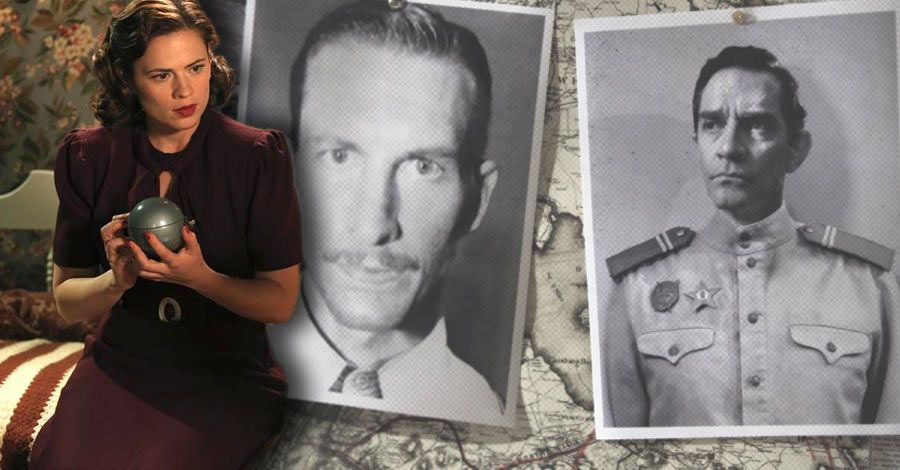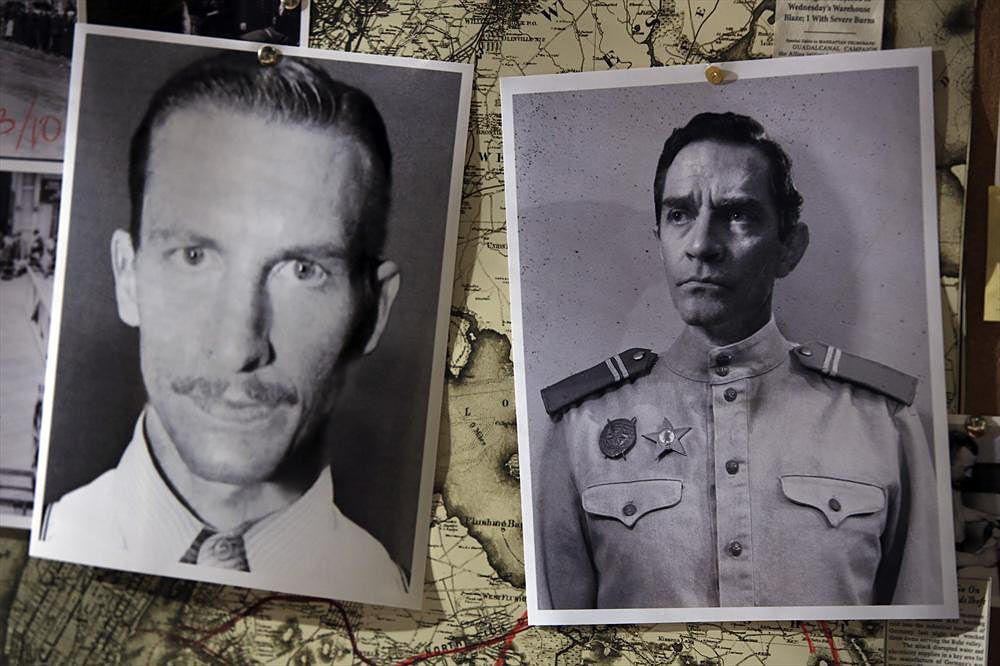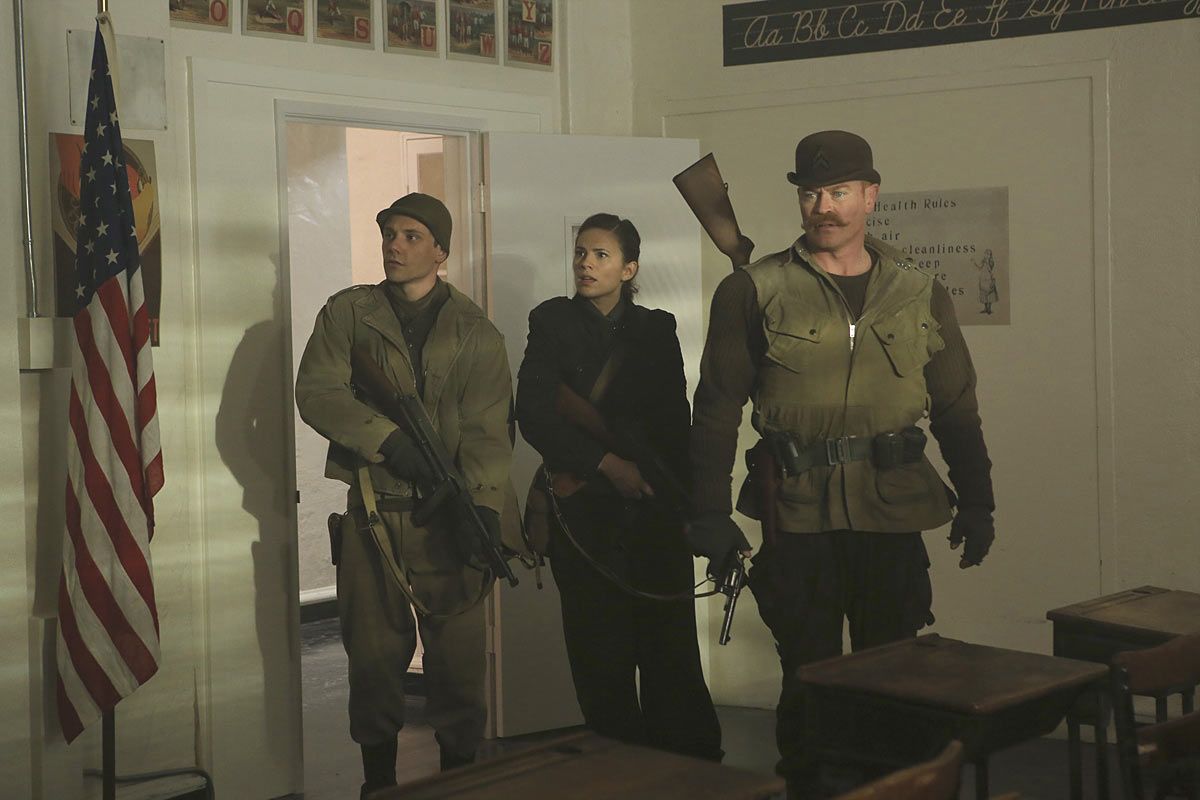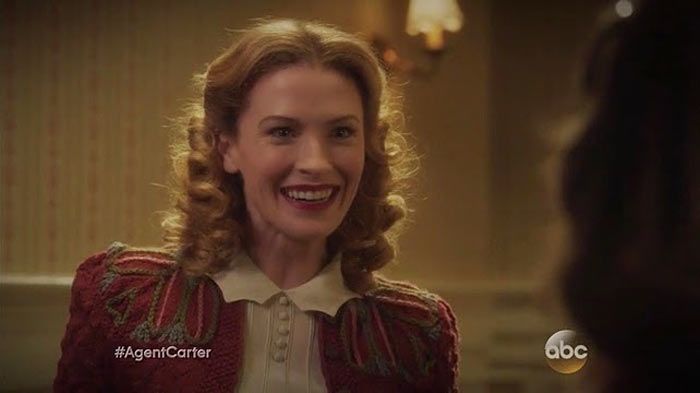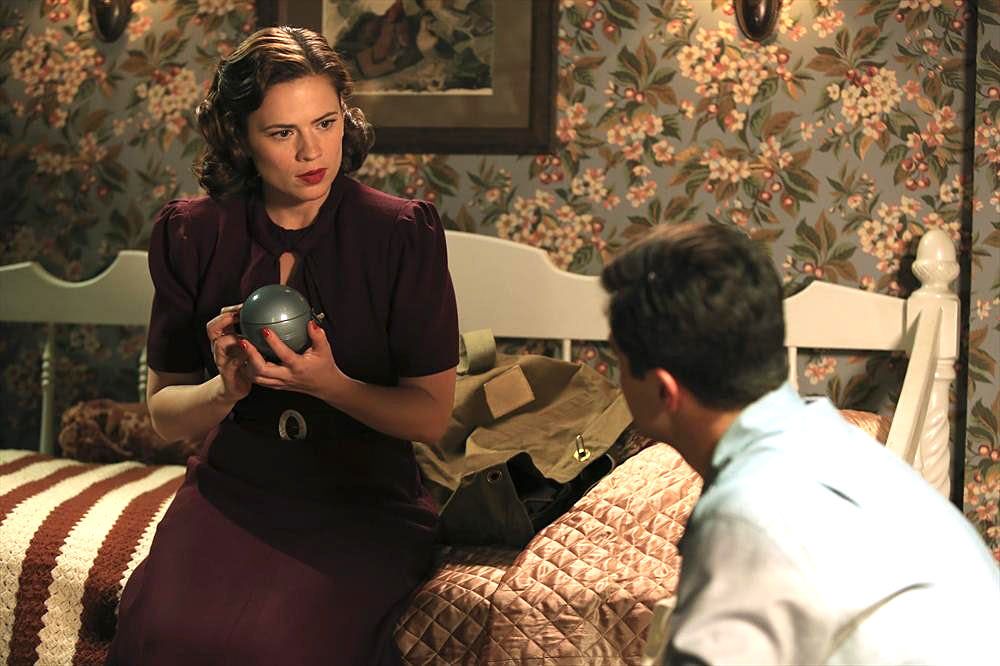[SPOILER WARNING for all of Marvel's "Agent Carter."]
Marvel's "Agent Carter" has, so far, leaned thematically on transitions: Peggy's transition from her important role in the war to a desk job at the SSR, Howard Stark's transition from hero to traitor, and -- most importantly -- the transition from Hydra's downfall to Leviathan's rise. By virtue of its setting, ABC's "Agent Carter" as a whole teeters on a fine edge, caught between post-WWII triumph and Cold War paranoia. In this, the show plays a crucial role in ushering in a new era defined by the Red Scare.
"Agent Carter" Recap: "The Blitzkrieg Button"
Though the audience understands that Hydra is not a problem that has been totally eliminated starting with this week's episode, "The Blitzkrieg Button," "Agent Carter" is slowly shifting the focus away from the war and onto the Soviets by introducing s slew of new villains, including Leviathan and the Red Room.
Leviathan
Let's back up a second to talk about Leviathan. Leviathan is actually a rather recent addition to comics lore; Jonathan Hickman and Stefano Caselli introduced it almost exactly five years ago in "Secret Warriors" #11. Nonetheless, Leviathan's fictional influence reaches back to the Cold War, borne as it was out of the Communist Bloc. In the comics, Leviathan's agents came from the East Bloc when 100,000 Soviet soldiers just disappeared; they were placed in cryonic suspension until they were needed.
Sound familiar? It should. Chief Dooley, Agent Thompson and the rest of the SSR gang are trying to get to the bottom of the mystery of Leet Brannis (James Frain) and Sasha Demidov (James Landry), two Soviet soldiers who evidently died in a battle at Finow. As recently as "The Blitzkrieg Button," we learned from a captured Nazi general that there was no battle, that when the Germans arrived they only found a pile of bodies -- a story taken almost beat-for-beat from the comics. For comic books and their on-screen counterparts, that's all pretty straightforward.
The Super Soldier Serum is where it gets interesting. Now, comics Leviathan never had the original, Dr. Erskine-created formula for the serum; they were able to manufacture their own from Brood alien technology and specialized holding tanks. Their intent was to mass produce super soldiers for the Soviet Union. Marvel Cinematic Universe Leviathan, as shady and mysterious as it is, has no confirmed contact with the Brood or even the Kree, which -- in the MCU's timeline -- would be in Hydra's hands at this point. It would be a small alteration to make Leviathan's goal the few vials of Captain America's blood that remain: the ones belonging to the government and the one in Howard Stark's possession.
In "Time and Tide," Peggy and Jarvis discovered all of Stark's inventions stored in a ship not terribly far from his mansion. The inventions were left discarded and not very heavily guarded, with a mysterious figure in a fedora (more on him -- or her? -- later) arriving on the scene just afterwards. What's more, nothing was done with these weapons but for the renegade, Brannis , who stole it for his own purposes. Is it possible the weapons -- and Cap's blood in particular -- were left there for a pickup by Leviathan? That Stark's other "bad babies" weren't the target, but the vial of Cap's blood alone was?
The Red Room
At this point, you're probably asking yourself: What does this have to do with the Red Room? Or, maybe, what is the Red Room? Allow me to explain.
The Red Room is a crucial part of Black Widow's background. In the comics, Black Widow is brought up there and trained as an assassin along with twenty-seven other girls. This secret training facility flies under the radar as a ballet school while, in reality, it churns out Soviet super spies. The Red Room brainwashes its pupils to ensure loyalty to their cause and even plants fake memories in an effort to retain them.
As of yet, there is no Red Room in the MCU, but the films have left plenty of clues. Natasha often speaks about how she is Russian, that she's worked for the KGB and had her mind altered. Recent "Avengers: Age of Ultron" trailers cut away briefly to silhouetted shots of ballerinas in practice. In all but name, the Red Room's presence looms over the MCU.
Here, we return again to the Super Soldier Serum. The comics version of the Red Room treated Black Widow with its own brand of the Super Soldier Serum, which in turn granted her superhuman abilities like enhanced speed, durability and strength. Though we have no confirmation that Natasha possesses these abilities in the MCU, we also have no background on her before we meet her in "Iron Man 2" -- though that will change soon.
Showrunners Tara Butters and Michele Fazekas recently confirmed that a character in the series, Dottie Underwood, is a product of the early Black Widow program in an interview with IGN. Though not called by the same name directly, the Red Room appears in the trailer for "The Iron Ceiling," which finds Peggy and the Howling Commandos in Russia with a little girl who is much more dangerous than she appears.
As it stands, then, Leviathan and the Red Room have two very big, very important things in common: loyalty to the Soviet cause and lust for the Super Soldier Serum. And what does that mean for the MCU? Why, they're going to join forces, of course!
Dottie Underwood
All right, you've got me -- I don't know for sure that Leviathan and the Red Room are going to join forces on "Agent Carter." I can, however, offer you my most critical piece of evidence: Dottie Underwood.
Dottie -- if that really is her name -- was introduced in "Time and Tide" alongside that mysterious figure in the fedora on the docks. She arrived at the Griffith in a red sweater while Miriam Fry sang her praises, citing Dottie's aspiration to become a ballet dancer. Two things immediately sent up a flag here: first, and more innocuously, the color of her sweater and, second, her cover story. As we see in "The Blitzkrieg Button," the wide-eyed Midwestern belle is just an act and she has more nefarious plans in mind, but that cover -- an aspiring ballet dancer -- stands out because it's what initially links her to the Red Room and the Black Widow program.
What's more, Dottie just happens to arrive in town at just the same time as the mysterious figure in the fedora, inevitably linking the two. For this particular character, the camera work is angled so that you can only see the back of the figure's head, but a woman's hair can easily be concealed if pulled up under a hat. As Butters and Fazekas and the episode "The Blitzkrieg Button" confirmed, Dottie is not only is masterfully trained to fight but she is very fond of revolvers -- fond enough, in fact, to kill for one. Due to circumstantial evidence and recent events, it appears as though Dottie and the mysterious figure are one and the same.
If Dottie and the mysterious figure are indeed the same character, that would align their goals. In "Time and Tide," the mysterious figure saw Peggy discover the weapons and call them in; in "The Blitzkrieg Button," Dottie seemed prepared to violently pursue Peggy for... something. If they are the same, then, the goal and method would sync up. Surely Dottie, as Peggy's neighbor, could overhear the shouting match between Peggy and Howard. Surely Dottie, learning that the true prize was with Peggy, would go after the person holding the target.
With deadly training and a tight alias, Dottie could easily take up the role of any number of characters, but these three characters look most likely:
Black Widow: No, not that Black Widow. Like most superhero mantles, Black Widow is a legacy title, one most recently taken up by Yelena Belova. Like Natasha, comics Yelena is both Russian and trained extensively in a modern iteration of the Red Room, though she never underwent the knockoff Super Serum procedure that Natasha did. Tall, blonde, and blue-eyed, Dottie fits Yelena's description to a T. Though Butters and Fazekas denied the name Yelena in the same interview they confirmed the Black Widow program, never say never -- they could always be leading viewers astray to make the reveal that much more of a surprise. Just don't expect her to be called Black Widow in this series.
Madam Hydra: Don't read into that title too much -- in the comics, Valentina Allegra de Fontaine is a S.H.I.E.L.D. agent turned Hydra spy turned Leviathan mole. As a triple agent, she assumed many roles and executed them flawlessly enough to trick even Nick Fury into believing her. She's also skilled in hand-to-hand combat and weaponry.
Viper: Though she flew under the flag of Madame Hydra for a while, Ophelia Sarkissian eventually settled for Viper when she severed ties with the organization. A Jim Steranko creation, Viper frequently bumped heads with Cap and the Avengers. She's even had a few run-ins with Hugh Jones, the president of Roxxon, who appeared in the "Bridge and Tunnel" episode of "Agent Carter." Like Yelena and Valentina, Viper has no powers but her training, strength and a fondness for pistols and handguns. Her history with Cap puts her in an excellent position to have it out with Peggy Carter, the next best thing.
So What about "Agent Carter?"
The Super Soldier Serum could be the MCU's replacement for the nuclear deterrent as the USA and the Soviet Union struggle to outdo one another in terms of super soldiers. The struggle for the Super Soldier Serum would be an undercurrent in the Cold War, restricted access for intelligence agencies to battle it out with coveted intel, gadgets and espionage. With the nuclear arms race as a cover, the SSR and Leviathan would be able to duke it out in secret as the public's attention is diverted elsewhere.
Dottie's assassination of Mr. Mink is symbolic, in a way -- a removal of the old German foe in favor of a newer, Russian threat (if, indeed, she acts on Leviathan's behalf). Between the captured Nazi and Mr. Mink's swift takedown, "Agent Carter" has made it clear that WWII is far behind us; we're moving forward into murkier waters where the distinction between good and evil isn't so clear and this new gray world will certainly test the mettle of Carter's character.
Dottie's connection to the Red Room has huge implications for the MCU at large, for it confirms that Natasha Romanoff was not alone in her training and that, indeed, there is a history to the title Black Widow. As Natasha still won't be receiving her own movie, "Agent Carter" is a fantastic opportunity to further flesh out the character by giving the organization that trained her a rich history. What's more, this makes "Agent Carter" suddenly very relevant to the modern mythology of the cinematic universe.
Though "Agent Carter" is certainly a stride forward for the women of the MCU, it could be argued that it hasn't accomplished much outside that pigeonhole. By using the Red Room and tying the show into the Black Widow mythos, "Agent Carter" becomes more than a fun feminist romp through the 1940s; it instantly becomes a critical piece in the overall universe and serves the larger purpose of Marvel's interconnected films. While keeping it light, a move like this is essential to the ratings and voice of the show, in much the same way "Agents of S.H.I.E.L.D." needed to forge its own mythology with the Inhumans. Now halfway through the miniseries, "Agent Carter" is stepping up its game in the same way -- and that's the best thing for it.
Marvel's "Agent Carter" airs Tuesdays at 9pm on ABC.

